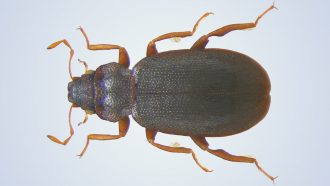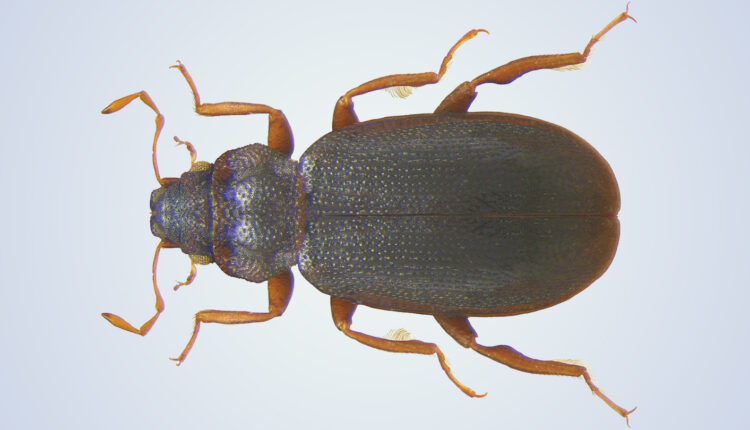
Being quite small, insects can have a very different relationship with the water-air interface than larger animals do. Surface tension allows for insects like water striders to skate along the top of still waters, for example. But new research reveals an unusual way to tread along this boundary: from the underside.
A water-dwelling beetle can scuttle upside-down along the underside of the water’s surface, as if the water were a solid pane of glass, researchers report June 28 in Ethology. It’s the first detailed documentation of a beetle moving in this manner, which is known only in precious few animal groups.
John Gould, a behavioral biologist at the University of Newcastle in Callaghan, Australia, hadn’t set out to look for beetles one night in the country’s Watagan Mountains, searching instead for tadpoles in ephemeral pools. In one of these pools, he spotted a black object smaller than a pinky nail.
“At first, I just assumed it must have been a bug that had fallen into the water and was swimming across the surface,” Gould recounts, “but then realized the bug was upside-down and below the water’s surface.”
As Gould quickly filmed the scene, the beetle walked under the water’s surface just as it would on a flat, solid surface, periodically resting and changing direction.
Later, Gould mentioned the encounter to his colleague Jose Valdez, a wildlife ecologist at the German Centre for Integrative Biodiversity Research in Leipzig. Valdez thought the observations were interesting, but he’d seen insects walk upright under water before.
“I didn’t fully grasp what he was describing until he showed me the video,” says Valdez. “Then I was floored.”
Searching the scientific literature, the researchers found that some snails could slide along the underside of the water’s surface on a layer of mucus, but little documentation of beetles walking this way existed — just passing mentions in decades-old papers.
It’s a publication gap that surprised Martin Fikáček, an entomologist at National Sun Yat-sen University in Kaohsiung, Taiwan. The under-surface walking ability is known to aquatic beetle specialists, who exploit the behavior when collecting the beetles. Researchers will unsettle the pond bottom and the beetles float to the surface, where they skitter around upside-down, he explains. But no one had looked closely at the phenomenon.
“It’s actually cool that somebody started to think about [the beetles’ abilities], because we always see it and we never even thought about it,” says Fikáček, who was not involved with this research.
Gould and Valdez identified the insect as a minute moss beetle (family Hydraenidae), but Fikáček thinks it’s actually a water scavenger beetle (family Hydrophilidae). He says he’s seen both beetles move this way.
What’s still unclear is how the insect physically manages this feat, but the researchers have an idea. Gould’s recording of the beetle showed an air bubble trapped along the creature’s upturned belly. The team thinks the bubble’s buoyancy may be flipping and pinning the beetle to the underside of the water’s surface. That allows the insect to put pressure on the water-air boundary with every step, creating what Gould observed as tiny hills of water sprouting from the beetle’s feet.
“It would have been really interesting to know which parts of the animals are [water-repellant] and which are not, as well as information on feet anatomy,” says Tom Weihmann, a movement physiologist at the University of Cologne in Germany not involved with this study. The beetle might be pushing off against the water like the researchers describe, he says, but this would mean the beetle’s feet are attracted to water, contrasting with a water-repellant body.
Gould and Valdez think the beetle might use this water-walking superpower to stay far away from ambush predators that lurk along the bottom of these pools. But this must be sussed out with additional research.
Future research might reveal if the beetles can switch to the opposite side of the water-air interface and leave the water entirely. Additional studies on the physics of the beetle’s upside-down water-walking prowess could also inspire advancements in robotics, as has been accomplished with water striders, the team notes (SN: 7/30/15).
The findings highlight how often we ignore or miss the amazing things the smallest animals are doing every day, Gould says. “Describing the natural history of the small is just as important as describing the natural history of any large mammal or bird.”


